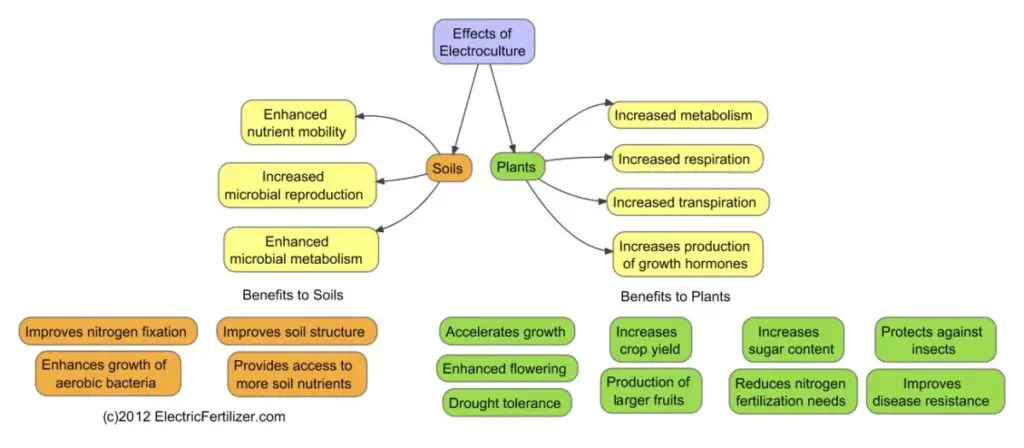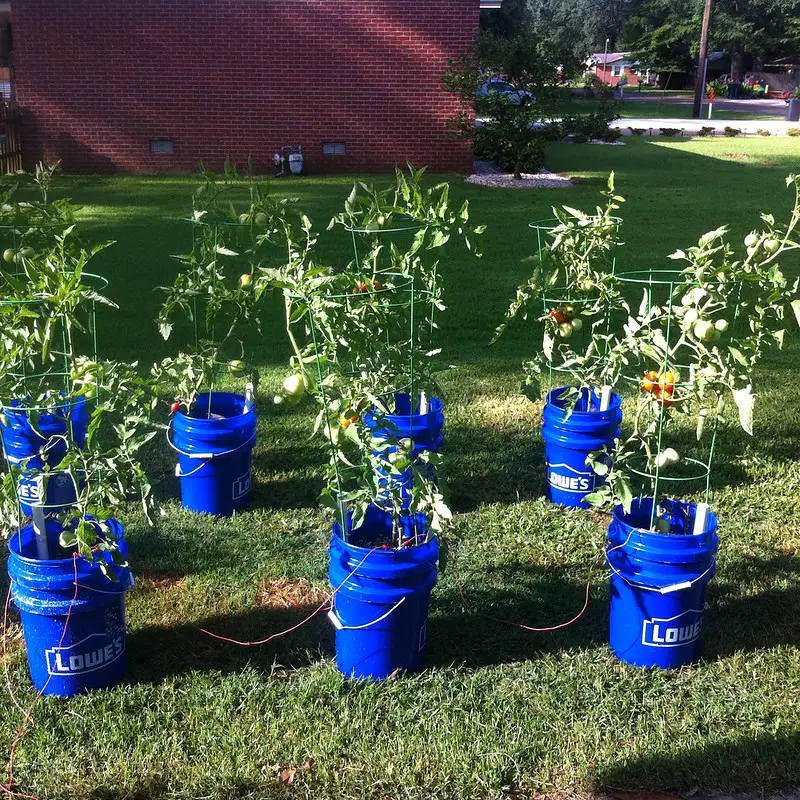In the pursuit of improving crop growth and agricultural productivity, innovative techniques continue to emerge. One technique gaining attention is electoculture, which involves harnessing electrical technology to stimulate plant growth. We will explore the concept of electroculture, its historical background, working principles, benefits, challenges, and its potential to revolutionize agriculture.
Table of Contents
What is Electroculture?
Electroculture refers to the application of artificial or amplified natural electricity in agriculture to enhance the growth of plants. It involves various systems and techniques that can be utilized before sowing seeds or during plant growth stages. By leveraging electrical fields, electroculture aims to optimize plant development, increase crop yields, and promote sustainable farming practices.
The Historical Perspective of Electroculture
The concept of using electricity to stimulate plant growth dates back to the 18th century. Over time, scientists and entrepreneurs have explored the potential of electroculture, with significant research conducted in the early 20th century.
However, the practical implementation and affordability of electroculture posed challenges, leading to limited adoption in mainstream agriculture.
Electro-Magnetic Terro-Celestial Power in Gardening
One notable application of electroculture is the concept of electromagnetic terro-celestial power in gardening. This approach, pioneered by Karl Selim Lemström in the late 19th century, involved using “electro-magnetic terro-celestial” energy to stimulate plant growth.
While exploring the Aurora Borealis, also known as the Northern Lights, he developed a curiosity about its potential impact on plant growth. This interest sparked when Lemström observed the remarkable growth rate of trees in the northern regions, despite the limited duration of the growing season.
His research found:
“An increase of the harvest of every kind of plant which has come under treatment, but also a favourable change of their chemical compounds.”
Lemström’s experiments gained significant attention and were widely reported in gardening circles and the press, contributing to the early exploration of electroculture.
How Electroculture Works
It operates on the principle of utilizing electric fields to influence plant growth and development. Electrical energy, whether artificially generated or amplified from natural sources, interacts with plants at a cellular level, potentially affecting various physiological processes.
Installing Atmospheric Antennas
When harnessing Earth’s energy, atmospheric antennas are placed directly in the soil, this should increase the magnetism of the soil, leading to more nutrients in the long run.
Constructed from materials like wood, copper, zinc, and brass, they capture various frequencies from the surroundings and enhance both the magnetic field and the flow of sap, which is essentially the plant’s lifeblood.
By harnessing the earth’s energy through vibrations and frequencies generated by elements like rain, wind, and temperature changes, these antennas contribute to the growth of healthier plants, increased soil moisture, and a decrease in pest infestations.
Read more about how to promote electroculture with copper wire in your garden.
Electrifying the Plant, Water, or Soil
Electricity can also be applied directly to the plant, water, or soil. This can be done using low-voltage electricity (around 12 volts) and conductor materials like iron or copper. It’s important to follow the recommended procedures and safety guidelines to avoid possible injury or create safety hazards.
Creating an Electromagnetic Field
Another electroculture technique involves creating an electromagnetic field around the plants. This can be achieved by positioning electromagnetic devices or by implementing conductive materials in the vicinity of the plants. Ideally, the antenna should be placed in close proximity to the plant’s root zone.
The process can include the installation of copper antennas throughout the field, which generate weak electrical currents when connected to a power source. These currents, when exposed to the plants, stimulate cellular activities and nutrient uptake, leading to enhanced growth and vitality.
It’s important to establish proper electrical connections between the copper antennas and the power source. Adhere to electrical safety protocols and ensure appropriate insulation to prevent any hazards. You can experiment with different setups and observe the effects on plant growth and health.
Benefits of Electroculture in Agriculture
By leveraging electrical technology, and the Earth’s magnetic fields this method offers potential advantages that can contribute to sustainable and efficient farming practices. Let’s explore some of the possible benefits.

Electroculture benefits
Electroculture Techniques for Seed Treatment
These techniques can be applied to seeds before sowing to enhance their germination and early growth. Electrical treatments, such as exposure to specific frequencies or intensities of electric fields, may stimulate seed dormancy breaking, leading to faster and more uniform germination. This approach has the potential to improve seedling establishment and increase crop uniformity.
Enhanced Crop Growth and Yields
During plant growth stages, electroculture techniques can be employed to stimulate overall plant development and optimize physiological processes. Electrical stimulation may promote:
- Root growth
- Nutrient absorption
- Photosynthesis
Leading to enhanced plant vigor and productivity. Various methods, such as applying specific electric field patterns or using electrode systems, and copper atmospheric antennas, can be utilized to deliver the electrical stimulus effectively.
Research conducted by a team of researchers in China suggests that this technic can increase agricultural yields. By stimulating plant growth and optimizing plant physiological processes, electroculture techniques have the potential to enhance crop productivity.
- Improve growth rates
- Enhance plant metabolism
- Faster crop maturation
- Increased biomass production
- Overall plant health improvement
This can be particularly beneficial in addressing global food security challenges and meeting the increasing demand for agricultural products.
Sustainable Farming Practices
The application of electroculture aligns with the principles of sustainable agriculture. It offers an environmentally friendly approach to crop cultivation.
- Reducing the need for synthetic fertilizers and chemical inputs
- Optimizing nutrient uptake and utilization
- Minimizing wastage and nutrient runoff
- Better utilization of fertilizers and reduced environmental impact
This can lead to improved soil health, minimized environmental pollution, and the preservation of natural resources.
Reducing reliance on synthetic inputs and optimizing resource usage, gives a potential solution for farmers seeking to minimize environmental impact while maintaining or increasing productivity.
Other sustainable practices include Regenerative Agriculture, which focuses on regenerating soil health.
Pest and Disease Management
Electroculture may have indirect effects on pest and disease management. Electric fields could potentially disrupt the feeding patterns of insects and inhibit the growth of certain pathogens, offering a natural and chemical-free approach to crop protection.
Electrical currents and fields can:
- Stimulate natural defense mechanisms
- Make plants more resilient to diseases and pests
- Strengthen plant immunity
- Reduce the reliance on chemical pesticides and fungicides
- Promote sustainable pest management practices
Challenges and Limitations of Electroculture

Electrical stimulation of tomato plants
Despite the potential benefits, electroculture still faces several challenges and limitations. Some of the key obstacles include:
Limited Scientific Understanding
The mechanisms are not yet fully understood, and further research is required to elucidate the precise physiological and biochemical responses of plants to electrical stimuli. This knowledge gap hinders the widespread adoption and optimization of electroculture techniques.
Implementation Costs and Practicality
The practical implementation on a large scale can be challenging and costly. It often requires considerable investment in infrastructure, electrical systems, and specialized equipment. The installation and maintenance of electrical systems over extensive agricultural areas may also pose logistical difficulties.
Standardization and Regulation
As this method gains attention, standardization and regulation of techniques and equipment become crucial. Establishing guidelines, safety protocols, and quality standards will ensure the effective and safe implementation of electroculture practices.

Copper wire antenna
The Future of Electroculture
As research and understanding of this practice continue to advance, the future holds exciting possibilities for its integration into mainstream agriculture. Some potential developments include.
Precision Electroculture
Advancements in technology and data analytics can enable the implementation of precision electroculture. By utilizing sensors, machine learning algorithms, and real-time monitoring, farmers can tailor electrical stimuli based on specific crop requirements, optimizing the effectiveness of electroculture techniques.
Integration with Smart Farming Systems
Integration into smart farming systems is possible, where automated and interconnected devices work together to optimize crop management. By integrating electroculture with other technologies such as precision irrigation, remote sensing, and autonomous machinery, farmers can achieve more efficient and sustainable agricultural practices.
Collaboration and Knowledge Sharing
Collaboration among researchers, agronomists, and farmers is crucial for further advancing electroculture. Sharing knowledge, experiences, and best practices can accelerate the development and adoption of electroculture techniques worldwide. Collaborative efforts can also address challenges and refine applications for different crop varieties and farming systems.
Commercialization and Accessibility
As electroculture matures, efforts to make it more commercially viable and accessible will be essential. This includes developing cost-effective solutions, improving scalability, and providing support and training to farmers interested in adopting electroculture. Increased commercial availability and affordability will drive wider adoption and facilitate the realization of electroculture’s potential.
Electroculture: Debunking Misconceptions
Despite its potential, electroculture has been met with caution and skepticism. It is important to address some common misconceptions:
Electroculture is not Electroshock Therapy for Plants
It does not involve subjecting plants to harmful electrical shocks. Instead, it focuses on applying controlled electric fields to stimulate plant growth through physiological responses.
Electroculture is not a Panacea
It is not a cure-all solution for all agricultural challenges. It should be viewed as a complementary approach that can enhance crop growth and yield under appropriate conditions, alongside other proven agricultural practices.
Research is Ongoing
While this tactic shows promise, it is still an evolving field of research. Continued scientific investigation and experimentation are necessary to refine techniques, understand underlying mechanisms, and optimize the implementation of electroculture in different agricultural contexts.
Electroculture and the Global Agricultural Revolution
Electroculture has the potential to contribute to a global agricultural revolution by revolutionizing farming practices, increasing productivity, and promoting sustainability. By harnessing electrical technology, farmers can optimize resource usage, reduce reliance on synthetic inputs, and enhance crop yields, ultimately contributing to global food security and economic growth.
Although it is still an evolving field with ongoing research, it holds great promise for sustainable farming practices, resource optimization, and increased agricultural productivity. By addressing challenges, promoting collaboration, and advancing technology, it can contribute to the transformation of the agricultural industry.
FAQs
1. Is electroculture safe for plants and the environment?
When applied within appropriate parameters it’s considered safe for plants and the environment. However, it’s important to follow recommended guidelines and safety protocols to ensure proper application and minimize potential risks.
2. Can electroculture be applied to all types of crops?
These techniques can be applied to a wide range of crops. However, the effectiveness may vary depending on the crop species, growth stage, and environmental factors. Further research is needed to determine the optimal application of electroculture for different crops.
3. Does electroculture require extensive technical expertise for implementation?
While it can involve specialized equipment and technical knowledge, it does not necessarily require extensive expertise for implementation. With proper training and guidance, farmers can adopt electroculture techniques and integrate them into their existing farming practices.
4. How long does it take to see the effects of electroculture on crop growth?
The time required to observe the effects on crop growth can vary depending on several factors, including the crop type, growth stage, and the specific techniques employed. In some cases, noticeable changes in plant growth and development may be observed within weeks, while in others, it may take longer.
5. Can electroculture completely replace traditional agricultural practices?
It’s not intended to replace traditional agricultural practices but rather to complement them. It offers an innovative approach to enhance crop growth and optimize resource utilization. By integrating electroculture with existing agricultural practices, farmers can potentially achieve improved productivity, sustainability, and resource efficiency.
6. Is electroculture economically viable for small-scale farmers?
The economic viability for small-scale farmers can depend on various factors, including the cost of implementation, access to resources, and market conditions. While there may be initial investment costs, potential benefits such as increased yields and resource savings could contribute to long-term economic viability. Further research and development efforts to make it more accessible and affordable can help facilitate its adoption among small-scale farmers.
7. Are there any environmental benefits associated with electroculture?
It offers potential environmental benefits by reducing the reliance on synthetic inputs such as fertilizers and pesticides. By optimizing nutrient uptake efficiency and promoting natural plant defenses, electroculture can contribute to reduced chemical runoff, minimized environmental pollution, and improved soil health. However, it is essential to implement these techniques responsibly, following best practices and environmental guidelines.


